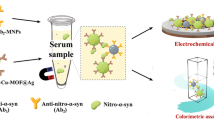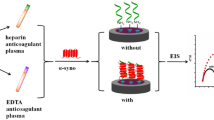Abstract
A highly sensitive and specific surface plasmon resonance (SPR) method using one anti-alpha-synuclein antibody (anti-αS) and titanium phosphate nanoparticles (Ti4+@TiP) was developed for quantitative evaluation of phosphorylated αS level which was defined by the ratio of p-αS to total alpha-synuclein (t-αS) (p-αS/t-αS). The close affinities of anti-αS to αS (0.975 pM−1) and p-αS (0.938 pM−1) were obtained. Based on this fact , both αS forms were simultaneously captured and the t-αS was quantified using the anti-αS immobilized Au chip. With the selective recognition of Ti4+@TiP nanoparticles, the p-αS was quantified. The dynamic ranges of our method were 1.0~20.0 pg mL−1 for the detection of t-αS and 0.1~10.0 pg mL−1 for that of p-αS. The analysis of αS- and p-αS-spiked artificial cerebrospinal fluid samples revealed the high accuracy of the method. Furthermore, the concentrations of αS and p-αS in clinical CSF samples collected from three healthy donors were determined and displayed a high correlation with the results from a commercial ELISA kit, confirming the viability and of the proposed method. The method is convenient, economical, and practical for the evaluation of phosphorylated αS level with high sensitivity and selectivity. It is of great significance for the early diagnosis of PD and the evaluation of PD progression.
Graphical abstract







Similar content being viewed by others
References
Atik A, Stewart T, Zhang J (2016) Alpha-synuclein as a biomarker for Parkinson’s disease. Brain Pathol 26:410–418
Pan C, Zhou Y, Dator R, Ginghina C (2014) Targeted discovery and validation of plasma biomarkers of Parkinson’s disease. J Proteome Res 13:4535–4545
Martin I, Dawson VL, Dawson TM (2011) Recent advances in the genetics of Parkinson’s disease. Annu Rev Genomics Hum Genet 12:301–325
Irizarry MC, Kim TW, Mcnamara M, Tanzi RE, George JM, Clayton DF, Hyman BT (1996) Characterization of the precursor protein of the non-A beta component of senile plaques (NACP) in the human central nervous system. J Neuropathol Exp Neurol 55:889–895
Lee MY, Trojanowski JQ (2006) Mechanisms of Parkinson’s disease linked to pathological α-synuclein: new targets for drug discovery. Neuron 52:33–38
Wang Y, Shi M, Chung KA, Zabetian CP, Leverenz JB, Berg D, Srulijes K, Trojanowski JQ, Lee VM, Siderowf AD (2012) Phosphorylated α-synuclein in Parkinson's disease. Sci Transl Med 4:121ra120
Zhu M, Qin ZJ, Hu D (2006) Alpha-synuclein can function as an antioxidant preventing oxidation of unsaturated lipid in vesicles. Biochemistry 45:8135–8142
Murphy DD, Rueter SM, Trojanowski JQ, Lee VM-Y (2000) Synucleins are developmentally expressed, and α-synuclein regulates the size of the presynaptic vesicular pool in primary hippocampal neurons. J Neurosci 20:3214–3220
Trexler AJ, Rhoades E (2009) Alpha-synuclein binds large unilamellar vesicles as an extended helix. Biochemistry 48:2304–2306
Jonas K, Andres B, Marchel S, Silvia V, Francois-Xavier T, Beata B, Marleen VR, Philipp S (2014) Efficient modification of alpha-synuclein serine 129 by protein kinase CK1 requires phosphorylation of tyrosine 125 as a priming event. ACS Chem Neurosci 5:1203–1208
Sun K, Xia N, Zhao L, Liu K, Hou W, Liu L (2017) Aptasensors for the selective detection of alpha-synuclein oligomer by colorimetry, surface plasmon resonance and electrochemical impedance spectroscopy. Sensors Actuators B Chem 245:87–94
Yin G, Lopes da Fonseca T, Eisbach SE, Anduaga AM, Breda C, Orcellet ML, Szego EM, Guerreiro P, Lazaro DF, Braus GH, Fernandez CO, Griesinger C, Becker S, Goody RS, Itzen A, Giorgini F, Outeiro TF, Zweckstetter M (2014) Alpha-synuclein interacts with the switch region of Rab8a in a Ser129 phosphorylation-dependent manner. Neurobiol Dis 70:149–161
Mcfarland MA, Ellis CE, Markey SP, Nussbaum RL (2008) Proteomics analysis identifies phosphorylation-dependent alpha-synuclein protein interactions. Mol Cell Proteomics 7:2123–2137
Hideo F, Masato H, Naoshi D, Akiko K, Eliezer M, Goldberg MS, Jie S, Koji T, Takeshi I (2002) Alpha-synuclein is phosphorylated in synucleinopathy lesions. Nat Cell Biol 4:160–164
Foulds P, Mitchell J, Parker A, Turner R, Green G, Diggle P (2011) Phosphorylated α-synuclein can be detected in blood plasma and is potentially a useful biomarker for Parkinson's disease. FASEB J 25:4127–4137
Aponte AM, Phillips D, Harris RA (2009) 32P labeling of protein phosphorylation and metabolite association in the mitochondria matrix. Methods Enzymol 457:63–80
Haas A, Weckbecker G, Welzenbach K (2010) Intracellular phospho-flow cytometry reveals novel insights into TCR proximal signaling events. A comparison with western blot. Cytometry A 73:799–807
Domenico FD, Sultana R, Barone E, Perluigi M, Cini C, Mancuso C, Jian C, Pierce WM, Butterfield DA (2011) Quantitative proteomics analysis of phosphorylated proteins in the hippocampus of Alzheimer’s disease subjects. J Proteome 74:1091–1103
Jaros JAJ, Guest PC, Ramoune H, Rothermundt M, Leweke FM, Martins-De-Souza D, Bahn S (2012) Clinical use of phosphorylated proteins in blood serum analysed by immobilised metal ion affinity chromatography and mass spectrometry. J Proteome 76:36–42
Ptak A, Gregoraszczuk EL (2012) Bisphenol A induces leptin receptor expression, creating more binding sites for leptin, and activates the JAK/Stat, MAPK/ERK and PI3K/Akt signalling pathways in human ovarian cancer cell. Toxicol Lett 210:332–337
Yin Z, Wang S, Shen B, Deng C, Xiang J (2019) Coimmunocapture and electrochemical quantitation of total and phosphorylated amyloid-β40 monomers. Anal Chem 91:3539–3545
Nelson BP, Grimsrud TE, Liles MR, Goodman RM, Corn RM (2001) Surface plasmon resonance imaging measurements of DNA and RNA hybridization adsorption onto DNA microarrays. Anal Chem 73:1–7
Juan X, Jun G, Feimeng Z (2006) Scanning electrochemical microscopy combined with surface plasmon resonance: studies of localized film thickness variations and molecular conformation changes. Anal Chem 78:1418–1424
Zhai P, Guo J, Xiang J, Zhou F (2007) Electrochemical surface plasmon resonance spectroscopy at bilayered silver/gold films. J Phys Chem C 111:981–986
Kolomenskii AA, Gershon PD, Schuessler HA (1997) Sensitivity and detection limit of concentration and adsorption measurements by laser-induced surface-plasmon resonance. Appl Opt 36:6539–6547
Liu J, Wei X, Yu Y, Song J, Wang X, Li A, Liu XW, Deng WQ (2010) Uniform core-shell titanium phosphate nanospheres with orderly open nanopores: a highly active Bronsted acid catalyst. Chem Commun 46:1670–1672
Wang ZG, Zhang JL, Sun DH (2014) Novel Ti4+ chelated magnetic nanostructured affinity microspheres containing N-methylene phosphonic chitosan for highly selective enrichment and rapid separation of phosphopeptides. J Mater Chem 2:6886–6892
Hong Y, Yao Y (2018) Dendritic mesoporous silica nanoparticles with abundant Ti4+ for phosphopeptide enrichment from cancer cells with 96% specificity. Anal Chem 90:7617–7625
Liu F, Wan H, Liu Z, Wang H (2016) Preparation of polypropylene spin tips filled with immobilized titanium(IV) ion monolithic adsorbent for robust phosphoproteome analysis. Anal Chem 88:5058–5064
Kumar S, Wirths O, Stüber K, Wunderlich P, Koch P, Theil S, Rezaei-Ghaleh N, Zweckstetter M, Bayer TA, Brüstle O (2016) Phosphorylation of the amyloid β-peptide at Ser26 stabilizes oligomeric assembly and increases neurotoxicity. Acta Neuropathol 131:525–537
Okochi M, Walter J, Koyama A, Nakajo S, Haass C (2000) Constitutive phosphorylation of the Parkinson’s disease associated α-synuclein. J Biol Chem 275:390–397
Bhattacharjee P, Ohrfelt A, Lashley T, Blennow K, Brinkmalm A, Zetterberg H (2019) Mass spectrometric analysis of Lewy body-enriched alpha-synuclein in Parkinson’s disease. J Proteome Res 18:2109–2120
Sasakawa H, Sakata E, Yamaguchi Y, Masuda M, Mori T, Kurimoto E, Iguchi T, Hisanaga S, Iwatsubo T, Hasegawa M, Kato K (2007) Ultra-high field NMR studies of antibody binding and site-specific phosphorylation of alpha-synuclein. Biochem Biophys Res Commun 363:795–799
Majbour NK, Vaikath NN, van Dijk KD, Ardah MT, Varghese S (2016) Oligomeric and phosphorylated alpha-synuclein as potential CSF biomarkers for Parkinson's disease. Mol Neurodegener 11:3–15
Bidinosti M, Shimshek DR, Mollenhauer B, Marcellin D, Schweizer T, Lotz GP, Schlossmacher MG, Weiss A (2012) Novel one-step immunoassays to quantify alpha-synuclein: applications for biomarker development and high-throughput screening. J Biol Chem 287:33691–33705
Hong Z, Shi M, Chung KA, Quinn JF, Peskind ER, Galasko D (2010) DJ-1 and alpha-synuclein in human cerebrospinal fluid as biomarkers of Parkinson’s disease. Brain 133:713–726
Wang Y, Shi M, Lin X, Pan C (2012) Phosphorylated α-Synuclein in Parkinson’s disease. Sci Transl Med 4:121ra120
Landeck N, Hall H, Ardah MT, Majbour NK, El-Agnaf OM, Halliday G, Kirik D (2016) A novel multiplex assay for simultaneous quantification of total and S129 phosphorylated human alpha-synuclein. Mol Neurodegener 11:2–23
Funding
The work was financially supported by the National Natural Science Foundation of China (21573290), the Hunan Provincial Science and Technology Plan Project China (No. 2019TP1001), the Open Research Fund of State Key Laboratory of Physical Chemistry of Solid Surface, Xiamen (201814), and the State Key Laboratory of Fine Chemicals, Dalian University of Technology (KF1910).
Author information
Authors and Affiliations
Contributions
The manuscript was written through the contributions of all authors. All authors have given approval to the final version of the manuscript.
Corresponding author
Ethics declarations
Conflict of interest
The authors declare that they have no competing interests.
Additional information
Publisher’s note
Springer Nature remains neutral with regard to jurisdictional claims in published maps and institutional affiliations.
Electronic supplementary material
ESM 1
(DOCX 111 kb)
Rights and permissions
About this article
Cite this article
Yin, Z., Cheng, X., Wang, G. et al. SPR immunosensor combined with Ti4+@TiP nanoparticles for the evaluation of phosphorylated alpha-synuclein level. Microchim Acta 187, 509 (2020). https://doi.org/10.1007/s00604-020-04507-0
Received:
Accepted:
Published:
DOI: https://doi.org/10.1007/s00604-020-04507-0




